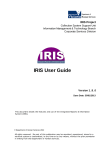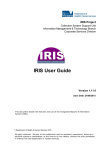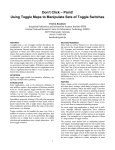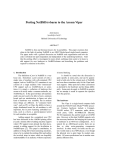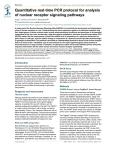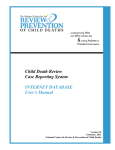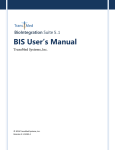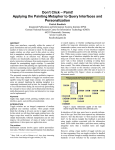Download RHYMIS Webinar 1: Learning to Upload RHYMIS Data Transcript
Transcript
RHYMIS Webinar 1: Learning to Upload RHYMIS Data Transcript Yonca: Okay. We are going to go ahead and get started. Welcome to today's introductory webinar. I am Yonca Ural, and I am a distance learning specialist at the American Institutes for Research, and I am introducing today's webinar. On behalf of HHF, I'd like to thank all of you for joining us. Today's webinar is learning to upload RHYMIS data. Next slide. Before we begin I would like to make a couple of logistical announcements. Today's webinar will last approximately an hour and is being recorded. The webinar recording and PowerPoint presentation will be posted on RHYTTAC website. Next slide. As an attendee of today's webinar your microphone will be automatically muted. We recommend using your computer rather than your phone to hear the audio for today's presentation. Due to the large number of attendees there might be a slight delay in the advancement of the slides. We will be holding a Q and A session at the end of the presentation, and the chatbox is the place that you can submit your questions. All of your questions are important but due to the volume of attendees, we may not be able to address them all at this time. If we don't answer your questions, please submit them to RHYMIS P-A at RHYMIS air dot org. We will actually be posting a document with all the questions that were unanswered with answers to the website as well. If you're experiencing any other technical difficulties, please also use the chatbox to request assistance. Next slide. Today's presentation will include a demonstration of how to upload your RHYMIS data. To see this webinar mostly clearly, you may want to use the blue, fullscreen button on the go-to webinar panel, so you can see the presentation in the larger format on your screen. You can also hide the webinar panel by clicking the orange arrow button. If you'd like to ask a question in the chat panel though, you'll need to click on the orange button again to expand it. Next slide. I'd now like to introduce the first presenter. Resa Matthew is the Director of the Division on Adolescent Development and Support for the Family and Youth Services Bureau. Welcome Resa. Resa Matthew: Thank you, Yonca and good afternoon everyone. I too would like to add my welcome to the rhenus data upload webinar. Just to give you a little bit of background in terms of my role as [inaudible 00:02:35], I am the Director for our position of Adolescent Development and Support. I have the oversight for our Adolescent Pregnancy Prevention program, as well as our Runaway Homeless Youth program in the Family Youth Services Bureau. I also wanted to take a couple of minutes to say, and express my appreciation to each of you for your diligence and working to connect with your local continuums of care, getting trained on using your local systems and entering your RHY data into your local Learning to Upload RHYMIS Data Page 1 of 15 RHYMIS HMIS system. I know this has not been without challenges and I appreciate your diligence in terms of working to get that information to us. Just to give you some background in terms of the reason why we went through this RHYMIS HMIS integration process is that several years ago, many of you expressed your concern about the burden of data entry into both our RHYMIS system and HUD HMIS system. We listened and we began having conversations with HUD, along with other federal agencies to include the Veteran's Administration and the Substance Abuse and Mental Health Services Administration to integrate our respective systems with HMIS. It's been a long process in terms of the numbers of meetings and conversations and making sure our data standards are well represented in the integration process, but I think that you will see that this integration will have several benefits to you. Next slide ... Next slide. Looking at how some of the benefits, as our runaway homes youth providers will see as part of this integration, is that for the first time ever we will have our runaway homeless youth data on homeless youth to become part of the largest, most comprehensive and annual report to Congress. I think this is something that we need to be proud of because we will definitely have our homeless youth representative part of the larger report to Congress. It will also be able to determine the actual numbers of youth served with our [inaudible 00:04:50] location, as they move between programs within their local CoC. It's not nationwide, but it's within their continuum of care. I know that this, some angst about entering social security numbers and to the extent that you can do so in your HMI system. I think that will help to look at number of homeless youth within a CoC that is unduplicated. It will also increase our ability to demonstrate outcome of our Runaway Homeless Youth Program. I know for the first time ever, we're collecting our street outreach program data at the individual level. We're hoping that will also continue to help us demonstrate outcome of all three of our funding streams in the runaway homeless youth program. Additionally, it will definitely increase access to non FYSB funded services for homeless populations. Dual of that collaboration and communication and cooperation with HUD program, your local continuums of care members and other RHY programs. Finally, granting you'll soon be having access to a dashboard to run reports and analyses of your own data. We think that will be a huge benefit to you as you want to look at your data and look at the services and see where you are in terms of the collection of your own homeless youth data. Next slide. We really wanted to have you walk away with some learning objectives for this webinar. At the end of this webinar, you will be able to first, identify the responsibilities that are specific to you as runaway homeless youth grantees, versus those for HMIS vendors. To gain access to the [inaudible 00:06:42] platform and use it to submit your RHYMIS data. Third, interpret your data quality report card and fourth, engage with your local HMIS resolve any problems with data submission. Next slide. Learning to Upload RHYMIS Data Page 2 of 15 I have the pleasure of introducing the next presenter who is John McGaff. John is the project director for the Runaway Homeless Youth Technical Assistance and Reporting Project. He's a Senior Associate at American Institutes for Research National Center on Family Homelessness. He's a former staple at HMIS Administrator and an HMIS evaluator and key provider. Let's welcome John. John McGaff: Thank you, Resa. I'll just move this slide over. Welcome everybody. Thank you Resa. Yes, I am the Project Director for the Runaway and Homeless Youth MISTA and Reporting Project. We're working very closely with folks at FYSB, Family and Youth Services Bureau and ODAIR on this project and partnered with Bowman Systems and National Safe Place Network. We are also closely coordinated with other TA providers because there's a lot of overlap between RHYMIS and extracting RHY data with HMIS TA and issues. We're very coordinated and been working with RHYTTAC folks and also HUD's HMISTA which comes in different forms. We're very excited to launch this for all the reasons Resa just went through. The benefits to grantees and to understanding program design and RHY data and the aggregate for better services to runaway and homeless youth. Thank you for joining us. What we'll be covering is specifically the upload process. How you extract RHY data from your HMIS system, which is required for the first time. It represents deeper integration than ever before around data collection between HUD and HHS. Which I think is very exciting and we're happy to be part of that. Once again, I want to mention also in this kickoff is that in addition to the collection of RHY data, there will be the reporting components that come early next year that Resa mentioned. Which will, as she said, give you more control of the data and we'll also be having some additional data collection around aggregate data for the street outreach programs. There will be more information around that to come after this first upload process. The last thing I'll mention, again to echo what Resa said, is this is the first time we're doing this with RHY grantees and HMIS and that integration. It's exciting but it's new. These are new processes, new ways of thinking of it, new expectations around data quality. We're going to be listening to you a lot. What's working, what could be improved, what could be tweaked. In addition to this webinar, which is the first of others to come, our team will be at the 2015 RHY Conference in New Orleans in November. We'll be presenting there, we'll have an exhibit and we'll be looking to talk to grantees and other folks involved with RHYMIS and HMIS to really learn from folks what are concerns, what's working, what could be improved. With that said, before we begin, we wanted to start with some poll questions. This allows us to just get a sense of who's in the webinar and familiarity with the CoC process and HMIS in general. The first question, Corey could you bring up the poll question, please? There it is. First question, and we'll see the results live ... How fully engaged would you say you are, as a RHY grantee, with your continuum of care or CoC? Are you fully engaged, yes or no? If you could answer that now online that will give us a sense. Give you a moment. Learning to Upload RHYMIS Data Page 3 of 15 ... Corey, if everyone's had a moment could you show those results? This will help us, not only for this webinar, to see in what detail we should go into but also moving forward with other resources. Okay, overwhelming majority feel fully engaged with your continuum of care and I should have said, to us that means you're regularly inputting data into HMIS. You're in contact with your HMIS lead, you may be involved with the coordinated entry with your CoC and it sounds like folks feel fully engaged. That's great. For those that are not, we'll continue to work with you in this process to make sure you're up to speed. Corey, could you post the second poll question, please? This is the last one. Are you familiar and comfortable with the CoC homeless management information system, HMIS? Are you entering data regularly? Are you in contact with your HMIS leads? Are you aware of data requirements for HMIS? If you could just indicate yes or no to start us off. I'll give you a moment. Corey, could we see those results please? Okay, a little less but still a good majority of folks are familiar and comfortable so that's great. For those that are not, again, we'll be sensitive to that because we know... I've met with some great RHY grantees that are not engaged at all with their CoC and we'll be working with those folks as well. Well, thank you. If we could go back to the slides. Corey, if I could have control back. Let's start off by look at what grantees are responsible for. Let me run these down. You're responsible for entering all data in to HMIS since October 1, 2014. Those are any open records as of October first, must be entered into HMIS or entered new October first or later, should be enetered into your HMIS system. You are responsible also for running the extraction. That is extracting your RHY data from HMIS, the process that we're going to go through now. Which is a process that your HMIS vendor, when you're working through your HMIS lead, is responsible for creating. You don't have to do that but you just have to run it. That extraction process will also de-identify client level records with a hash encryption that's been approved by HUD and HHS. You're responsible for running that system. You're responsible for checking data quality at all points in the process so that's looking at timeliness, accuracy. It's really thinking about and paying attention to how questions are asked, how data is entered into HMIS, tracking completeness for client records, tracking completeness for are all your clients entered for your RHY program and of course, accuracy. That should really begin now, not just when you go to upload data. We'll talk more about data quality. Then you're responsible for submitting that data into RHYPoint, which is the program that allows you to upload the data. It's an web-based portal that we're going to look at it specifically today. After that's done, you'll receive a data quality report and you'll be responsible for reviewing that report and making any corrections that the reports indicates are needed. Lastly, once you've updated and corrected your data and the quality is at a sufficient threshold, Learning to Upload RHYMIS Data Page 4 of 15 which we'll talk about, submitting that file again through RHYPoint, which collects it into a national RHYMIS data repository and then you're officially submitted. That will be required moving forward every six months, the first one being in the submission period between November sixteenth and December eighth which we'll go over in more detail. Next slide. A little background. What you need to know for context. Couple a things we want to at least mention to ground us before we go into the details. First is the Runaway and Homeless Youth Act which I'm sure many of you are very familiar with and certainly more familiar with me, although I've been getting a crash course. This is the source, the alpha. This governs the collection of youth data for the RHY program and is used to inform reports to Congress and program performance. For these reports to Congress, this is what we're collecting in part for. The data we collect in the aggregate, de-identified, will be part of a report to Congress on a regular basis. The second issue which is very important and has raised a lot of concern rightly in the field is around consent and privacy with data, sensitive data, for vulnerable youth who are experiencing homelessness. To be clear, it's not necessary to collect and report youth data to FYSB directly. It will be entered and collected into your HMIS and again, de-identified and reach FYSB that way but should be directly entered into HMIS. Then data sharing within your continuum of care has been a big issue. To be clear, around sharing within the CoC, written parental consent is required for youth who are under the age of 18. A parent must consent that this is allowable to share within the CoC. Data can be entered but to share with other programs, you need that parental consent. Another key point, written consent from youth for age 18 and older is also required and acceptable. If they're 18 or older, they can give that consent themselves to share. Lastly, again on data collection, as I mentioned, all new and open records as of October one last year, 2014, new and open as of that date or since that date, are required to be entered into HMIS and moving forward that's the case. Basic center program or PCP in transitional living program, PLP records, cannot be submitted for anonymous youth. There should be an identifier entered for those clients and again before that's uploaded to the repository through RHYPoint, they will be de-identified. That gives us some background again, around some important issues that we can always discuss further. Now I want to go through who it's important to work with in this larger process. Your HMIS vendor is a key stake holder in this. Again, they are required to create the extraction tool and process unique to your HMIS tool and that will also include the functionality for de-identifying. The deidentification creates a hash encryption which is technically an SA one hash encryption. It's important that their up to speed. That should be tested before you go to enter data and there should be no problems but if there is, you should talk to your HMIS lead and make sure that's resolved. Learning to Upload RHYMIS Data Page 5 of 15 Secondly, you should be aligned with your HMIS in general around HMIS issues, and your CoC. Make sure coordination is happening. Certainly the clients you are collecting data from. They're the source of this data and need to be collecting it in a consistent way that respects privacy and security and shared appropriately, that information. RHYMIS technical assistance, so that again is this process for extracting your data, uploading the data, checking it for quality. Later, early next year, reporting on your own data, that's all what we're doing. This team from myself, American Institutes for Research and our partners Bowman and National Safe Place Network. Lastly, just again to reiterate, there's other technical assistance that we'll coordinate with and you should be aware of, RHYTTAC, for other issues around RHY and data collection issues that aren't specific to uploading and then HUD HMISTA. Now let's look at the tasks. Here's a visual of the process. Three high level steps with some sub steps just for clarity. Step one is collecting your data, and collecting it into your HMIS. Step two is preparing it for upload. This is the functionality that is created by your HMIS vendor specific to your HMIS tool that your CoC is using. That includes two functionalities. One is two A here in the graphic. Extract the data so there will be likely a button which pulls the RHY data out for you and two B deidentifies the data with that hash encryption in that one step. That should then create a series of CSV files which are the format required and will put those files into a zip file and it's the zip file that is ultimately uploaded, which brings up to step three, uploading your data. That's what we're going to look in most detail here. You want to upload that data file. It's a zip file and that's your responsibility as a grantee. Three b, after you upload that, or I should say when you upload that, you'll get immediate word if there's any structural issues with those CSV files that are part of your zip. If there are structural issues, they way those files are set up, you can't upload your data, so that should be fixed and correct ahead of time, created by your HMIS vendor. If there's a problem you need to reach out to your HMIS lead to work with your vendor to fix that. Again, by the time you go to upload data they should have tested and corrected that. Assuming it's correct, three c, RHYPoint which is the portal interface, the web based interface, will send the data, will upload the data but then send a data quality report to you via email so you'll get a PDF file the following morning. It's important to know there's that little time delay because you may find some results in that data quality report that you need to address and it may not be instantaneous. If you start this process last minute, could be some issues so it's really important to remember. You get the data quality PDF report back, three b, step three b. You fix those data quality errors and you'll get instructions on how to read that data quality report and where specifically to fix your data so it is of a high quality, enough to upload. Then lastly, reupload that fixed data file, that zip file, into RHYPoint and then you're done. Learning to Upload RHYMIS Data Page 6 of 15 That's the process at a high level. You're HMIS is responsible for, again, extracting the RHY data from HMIS, deidentifying that data, all in one process, which they'll have created in showing you how to run that process. What data are required? There are couple of sets of data that you should be aware of. There's the universal data elements that all HMIS participants are required to collect and enter. Then some programs, actually yeah HMIS programs specific data elements, particular to different RHY programs. We just show three here to have it all fit in a visual way. Where you see the different types of RHY programs and you'll see there are some data elements that are required by some RHY programs and some are not. This just shows three as an example but there are twenty nine elements total and that full list of data elements can be found in the RHY program HMIS manual which can be located on the HUD exchange at HUD exchange dot info. Let's look again closely at the process. I'm kind of repeating with a little more detail what we've covered but we really want this to be as clear as possible. Again, we'll have some time for questions and answers at the end. Collecting the data into RHYMIS via RHYPoint, that web based interface. Let's talk about the submission deadlines and be careful and be clear about it. The submission period starts Novemeber sixteenth of this year, so fast approaching, and ends December eighth. In that period you can upload your data, and again I want to reiterate, this takes a couple days because once you enter your data it's the next morning that you get the data quality report and you may need to plan to fix that and reupload. Data quality should be happening now, that should be ongoing as much as you can. When you start the process, give your self some time. I would not start the seventh or eighth certainly. As soon as you can begin, the sooner the better, in case anything comes up that we can't predict with your data. The quality begins now, allow time, work with your HMIS lead to learn about how to extract your CSV file and that will contain your deidentification RHY records. Preparing your data for upload. Let's talk about the data extraction process. Again, all HMI [inaudible 00:27:34] are required to develop this functionality which pulls the data out from HMIS, creates a CSV export complying with the technical standards established by HUD and FYSB. It's certain RHY data tables, and certain deidentification again through a hash encryption. Any issues you have, you should reach out to your HMIS lead and if there are technical problems, ultimately they can work with you to reach out to the HMIS vendor, who ultimately has created this and fix it, if you have a problem. Hopefully you won't. You prepared it, now you're submitting it. This is what we're going to looking at some screenshots so it's very clear. It's a simple process, it doesn't take long but we just want to be clear on this webinar. First, you'll long into the RHYPoint data portal. You'll click the browse button which we'll look at and select your zip file which you've created. You'll submit that data by uploading. If there are any structural issues that the system sees with your CFV viles, you'll get an Learning to Upload RHYMIS Data Page 7 of 15 immediate error showing you what the issues are and you'll also get an email sent to you. Which you can then forward directly to your HMIS lead and possibly your HMIS vendor if needed to, so you'll have that as a resource. If there are no structural issues with your files, then the data will be accepted through RHYPoint and again, the next morning once the data is collected, once a day into the system, it will generate and you'll receive a data quality report around the content of your data. There are two things around data quality. One is the structure of the CSV files and secondly, is the content. How complete, how accurate are those data? Things like, are there any pregnant males that have come up? Or, someone outside of a date range. Things like that that just don't make sense. It will flag that for you. That's what the data quality check is, that report. I want to just mention the percentages for everybody. What FYSB has established in working with FYSB and ODAIR and thinking it through with us, are two thresholds to meet data quality minimum standards. This is just for the first upload process. It may get even higher as we move forward six months from now and this is an ongoing process. First of all, the file structure, the CSV, the integrity of those files, has to be a hundred percent. The way the fields are set up and those files, hundred percent accurate to be able to upload. The data content, the threshold is that all the required fields for your program or for your universal data elements required for all HMIS participants, has to be at least seventy five percent to meet the data quality standards. Again, that may go up as we move forward. Here's the screen, when you log in. We'll go through this quickly and then try to get to some questions and answers. Let's be clear. You log in to a URL, be RHYNIS dot net. This will be the log in screen. Your grantee point of contact will receive a username and password via email and you enter that username and password. Log in. Then you come to this dashboard for RHYPoint. This home tab is what we're looking at now. It shows you if there's any recently completed imports or files that are currently in the queue. Gives you a status report on this home tab on the left. The imports tab, which I just highlighted in red here, which is where you click to actually go to upload your RHY data that you've extracted. When you click on that imports tab, you'll see this import management screen and that very simply has the choose file button. You'll click that and it will show you your files on your computer, or on your server, and you can click on the zip file that you've created through your HMIS system with your RHY data. Click the choose file once you've selected the correct zip file then you just simply click on upload files. You'll see this spiral telling you uploading is happening. That's a good sign, and then hopefully if all goes well you'll get this indication that you've successfully uploaded your RHYMIS file, extracted from HMIS. You'll see the name of the file listed there and then you're good for the time being. You're still waiting for the next morning to get your data quality report and the PDF emailed to you but as Learning to Upload RHYMIS Data Page 8 of 15 of now it's been accepted and that tells you that the CSV structure of your upload is fine. Let's go to the next one.This shows you back to the home tab. You'll see that the files are uploaded and in the queue at the server. What's been completed is the other tab, as I mentioned. Let's look at, suppose you selected your file using RHYPoint as we just saw, but there were structural issues. Let's look at what that looks like. You're uploading, you see the spiral, moving forward, then clicking forward, you'll get this message fairly shortly. This reads that based on HUD CSV specifications, and HHS CSV specifications it will say, the file uploaded but is structurally invalid. Here we have an example of two messages you may receive immediately on your screen. Enrollment CSV file which is part of your zip that you've uploaded is missing, so that's a problem. Or, a particular CSV file, in this case client dot CSV, has some missing fields. If that's the case, you need to go back to your HMIS lead and get in touch, either together or separately with your HMIS vendor, that something wasn't created accurately. Hopefully most of you will not see this and will have tested this upload process beforehand but if it does happen, this is how you know you have to deal with it. Once it is accepted, you've fixed the structural issues or there was not an issue, as I mentioned you'll get a data quality PDF report emailed to you the following morning. That will give you this report and tell you what is the problem around quality. Here's an example. This actually may tweak a little bit but this is an example of, you'll see the fields, you'll see the number of clickable entry exits, number of non null values, the required values to not be null. You can have data values like client refused to answer, client did not know but null is not acceptable for the required elements, universal data elements or required specific to your RHY program. You'll get a report on whether you've been compliant or not, or have some issues. Actually I think this is an older version. The version you get won't be a letter grade per say but probably a green check or an x saying that there's some work to be done. Clicking forward, and then you'll have some more detail about the actual records that have to be addressed. You see in this example you get the client ID, entry date, exit date if its applicable, and then the fields and which are null. That allows you to go right to those data fields, right to the records, right to the specific field and for any null field, enter it. It may be something that wasn't entered or client refused to answer, something like that but it can't be null. Hopefully that's helpful. Once you've got this report, you've addressed the issues, then you have to allow time to upload the, to generate the ... I'm sorry let me back up. Once you've corrected it, you need to generate the extraction file from your HMIS with the RHY data, deidentified. Then upload that again through RHYPoint, because now you've corrected it and there should be no issues now. You'll be accepted and that needs to be completed a second, maybe third time, hopefully not, by December eighth to meet the deadline. Learning to Upload RHYMIS Data Page 9 of 15 Some resources that are available. I've mentioned them briefly but I just want to go through them in a little more detail. Who can help you? Our team is providing technical assistance around this process, so specific to this process. There's an email address here, you can email at anytime, RHYMIS at A-I-R dot org. You'll get a response if we need to talk to you we'll do that within twenty four hours. Again, allow time for that. If we get a call on the eighth it may not be possible to get you immediate ... Well actually, around the data submission, we will have immediate support but leading up to that, in between data submissions through the year, please allow twenty four hours. There will be a RHYPoint user manual available on the RHYTTAC website. That'll be up within a week and that's available for all grantees. Oops. RHYTTAC technical assistance, which you're familiar with, are available for general RHY issues, other data issues that are not specific to this RHYMIS process. RHYTTAC is available for that as you probably have worked with recently and through the years and there's their website there. There's also HUD TA and this is for assistance with HMIS and CoC issues, in case they overlap with the RHYMIS process. Technical assistance can be requested through HUD exchange dot info. At this link there are HUD regional teams that can coordinate to provide technical assistance for CoC, for your CoC within that region. There are also other resources but that request is needed to go through HUD exchange dot info. Lastly, your HMIS lead, if there are issues specific to your HMIS that should be the first point of contact for assistance with your system. They may need to reach out to the vendor or may not. Now we'd like to open things up to any questions and answers. Hopefully folks have been submitting in the chat box as Yonca mentioned at the opening. Folks available for Q and A are the following, Brett Brown, who you probably know as the Director of ODAIR and ACYF and HHS. Telesa Byrd, social science research analyst, also at ODAIR. Candice Hacker, who's the industry compliance officer, art gallery and art development manager at Bowman Systems, and Tim Hockaday, the product manager at Bowman Systems. We got a good team here, ready for any questions that come up about this process. With that, I'm going to hand it over to, back to Yonca. Yonca: Okay, great. Well we do have a lot of questions that are coming in. One of these I'm going to ask Telese to answer. The question is to clarify are RHY funded programs required to enter their data directly into the CoC designated HMIS system and prohibited from using separate database and then uploading their data into the CoC designated HMIS? Telesa Byrd: As it currently stands, that is correct. We have been urging grantees to connect with their HMIS CoC's and use that system to upload the data because that is the only way that right now, we can guarantee the security measures and guarantee that we will get the data that we need in time. Brett Brown: This is Brett Brown, can I just add to that a little bit? There are some data quality issues around that. I want to make sure that you don't just dump your data in Learning to Upload RHYMIS Data Page 10 of 15 twice a year into HMIS because there's not much opportunity to be sure the data are clean and ready to be uploaded. More importantly is we really are encouraging [inaudible 00:42:15] and one of the strong motivations for this move over to HMIS is to get our grantees actively involved with their local CoC's, including, where appropriate and the sharing of data on youth that's more relevant for eighteen and older because it has been, I think, found that by being able to do that one can improve the quality of service that you give to your youth. We just want to start building the foundation for stronger relationships with the other service providers, for multiple reasons. Yonca: Okay, are we ready for the next question? Brett Brown: Yep. Yonca: Okay. Here's a question, can the HMIS lead get a RHYPoint account or do the individual grantees have to upload their own data? Again, I think Telesa I'll ask you this question. Telesa Byrd: Currently we're asking that each grantee have their own account and I believe that's also due to privacy and security but John, or one of the technical people, you can follow in as to why it's important that this be a RHY account that's dedicated to individual grantees. John McGaff: Sure and ultimately it's the grantee's responsibility as it stands now so we want that to remain clear by giving access just to the grantee. To be honest I haven't heard that question before. I'd be reluctant to change that access but as it stands now, that's the policy. Yonca: Okay. Here's a question, what do we do if our RHY people haven't put any data in the system? John, I'm going to ask you that question. John McGaff: If RHY grantees have not entered their data into HMIS? Is that the question Yonca? Yonca: Well it just says, what should we do if our RHY people haven't put any data in the system? I'm not certain. John McGaff: If they haven't, there's getting it into the HMIS system and then there's extracting that data, getting it to the RHYPoint portal, that system. If either has not happened, the grantee should start doing it immediately. If they don't, they are non compliant and as I understand it will be recorded as such and will have some issues that they'll have to deal with. I'm not sure of the repercussions or that I can speak to that but they'll go on a non compliant list which goes to FYSB. Yonca: Telesa, here's a question, a programmatic question. For people who were not funded from, let's say, October first 2014 to April first 2015, they weren't Learning to Upload RHYMIS Data Page 11 of 15 funded during that period of time, will they have to enter any data for that period when they had no funding? Telesa Byrd: Yes, we do expect that grantees will upload the second level ... Well since we didn't do it iterations this time, we're only doing it once but we do expect to get fiscal year 2014, I mean 2015 data from those grantees. As has always been the case even with RHYMIS, the older version of RHYMIS. We still had grantees upload that last or second half of the annual data and this will be the same only we're only doing it once for the year. Yonca: Right, and in this case their program was in operation but it wasn't funded by FY-S-B, FYSB, at that time so their wondering if they should enter that data as well. Telesa Byrd: Oh you mean prior year's data? They only need to enter data for the time for the period that they were funded. Yonca: Okay, all right [crosstalk 00:46:58]. Telesa Byrd: If that means that, yeah... Yonca: Okay. John, have usernames and passwords been sent out yet? John McGaff: They have not. Those will be coming soon but they have not been sent yet. Yonca: Here's a question Telesa. A lot of youth coming in through the BCP programs don't have social security numbers. Will providers be penalized for this? Telesa Byrd: We ask that grantees make every effort to complete the demographic information, the profile information for each youth however, we also understand that pieces of information may not be available at the time and so there are several response categories that deal with this. Whether it's a partial social security number or that the youth refused or didn't know. Those are all options that a grantee can used but it has to have information there so that it's not null and therefore not a quality issue. Yonca: For you again Telesa, do we evaluate youth homeless status under HUD guidelines even though our agency's only RHY funded? Telesa Byrd: No, you will as always, you will continue to use the runaway and homeless youth, RHY Act definition of homelessness, unaccompanied youth, runaway youth, et cetera. Yonca: Do the HMIS leads already have the extraction report created? Telesa I don't know if you're the right person to answer this but I'll ask you. Learning to Upload RHYMIS Data Page 12 of 15 Telesa Byrd: It's actually the vendor, the HMIS vendor, who has created the export in whatever HMIS that you're using. It was a part of a mandate from HUD and FYSB jointly for technical standards. As they developed their system and the means of extraction, that was a part of the requirement. They have that and the HMIS leads, who are the people who most grantees will work with directly, they have been given information about reaching out to you all or at least being accessible so that they can be engaged to make sure that you understand whatever the process is for your respective data system. Brett Brown: Mostly commonly what they'll have done is create some sort of a report generator, a software, that will just generate the report. I hope it's as simple for you, it may not be, as hitting the button at which point the report will be generated. Maybe it will ask you for a little information like what dates do you want covered, things like that. What their producing is actually something that allows you to generate the report. I'm sure you'll have to do something to activate that and get the report generated. John McGaff: It will be a data file, data files that are generated. Yep. Yonca: As a follow, there seems to be some concern about if the HMIS leads does not set up the extraction process or deidentification because of lack of time for learning and implementing that. Telesa Byrd: Any grantee who is experiencing a challenge getting either in touch with their HMIS lead, finding out whether or not there is, whatever the process is. If they're having challenges with that, you should definitely reach out and contact us so that we can help make sure that you're engaged, but that should start sooner rather than later. Brett Brown: We have helped with that over the past number of months for grantees that have called us. We worked with our partners at HUD to get people on the ground talking to each other and to resolve any issues on that. Yonca: Here's another question Telesa. As far as consent to share, if a person does not have consent, does that mean that none of the information can be shared within HMIS including name? Telesa Byrd: I'd like to pass that to Brett, please. Brett Brown: Yeah, if there hasn't been consent given then you are not allowed to share that information with any other service provider other than the CoC. You're allowed to enter the data, you're allowed to use the data but you're not allowed to share the data. The only exception to that, which is in the RHY Act, has to do with a exception for statistical purposes. In the once a year in which the local CoC generates descriptive tables of all of the youth and adults that have, all the people who have been served by their continuum of care, they may access the data at that time only for that purpose. That's a minor issue. What I want to Learning to Upload RHYMIS Data Page 13 of 15 emphasize is that you cannot hand that information over to another program, not even another runaway or RHY program unless there's been consent given. Yonca: Here's a question about entering data and services into the HMIS for aftercare services given to RHY youth. We've been told that we should discharge youth when they leave the basic center, but if we do then we can't enter information for aftercare services. Telesa Byrd: Can I get some assistance from Resa on this as a program issue? Resa Matthew: Sure. In terms of aftercare services, my understanding of your local HMIS system is that you can still continue to enter the system of entered data as it pertains to aftercare services for youth. I'm hoping whoever posed that question, that I've answered it or addressed it. That's my understanding in terms of your local HMIS system. Yonca: Here's a question about the HMIS system. We enter all youth in our HMIS system regardless of funding sources. Will the extraction tool pull out the non FYSB funded youth? Tim I don't know if you're the right person to answer that? Telesa Byrd: The question is if people are using their HMIS to enter data about RHY youth as well as other program youth that they serve, [crosstalk 00:54:12] will we get RH-Y data only or will we get all of the data? Yonca: Mm-hmm (affirmative). Telesa Byrd: Our goal is to get R-H-Y data only. John McGaff: That's our understanding. That's how it will work. Brett Brown: There are measures within the information within each system that identifies youth who have received our RHY funding and are considered to be RHY youth. With RHYPoint they would use that in order to make the distinction. Resa Matthew: [crosstalk 00:54:54] Correct. I was going to refer whoever the question was to the RHY program set up manual that tells system administrators how to set up the RHY programs in the system and that should allow your vendor then to properly extract the data for the export, is by setting it up correctly. Yonca: Here is another question. How about a minor receiving services under minor consent? I'm not sure if that was attached to another question but Telesa if that question makes sense to you please speak to it. Telesa Byrd: If a young person, a person who is under the age of eighteen, provides written consent to share their own data, that sounds like that might be the question, whether that data can be shared. The data can be entered, just to reiterate, data can be entered into HMIS and shared with FYSB without written consent. Learning to Upload RHYMIS Data Page 14 of 15 However, to share that data, written consent from a parent or legal guardian is required for the youth and I believe, which I am not sure so I don't know if that person is maybe talking about a youth who is legally on their own. In such case I think that might be different than a young person who is not legally on their own. Brett Brown: Our guidance has been a consent for youth under age eighteen need to be given by the parents in order to share data. There are some states where the age of consent is below eighteen, could be sixteen probably in a couple of the states as well as fourteen. That's something that right now we're giving our general guidance is if it's under eighteen, you need a parental consent. That is something though that I would be interested in talking to people about at the conference, especially if you're going to be there. There's some interesting issues that have come up in the relationship between, and some differences between states and federal laws governing data access that we would like to explore. Yonca: Well, we're running out of our time now so I'm going to go ahead and wrap up the webinar if we can move on to the next slide please. Just to let you know we will have additional resources available on the RHYTTAC including a users manual, as well as the recording of this webinar. We're also going to post unanswered questions with answers to the RHYTTAC website and if you have any other questions please email RHYMIS at A-I-R dot org. Finally, we do have a brief questionnaire that you'll receive in an email. If you could please respond to that, then we can continue to improve the delivery of future webinars. I'd like to thank you all for your time today and have a wonderful day. Brett Brown: Wow. John McGaff: Thank you everybody. Learning to Upload RHYMIS Data Page 15 of 15















